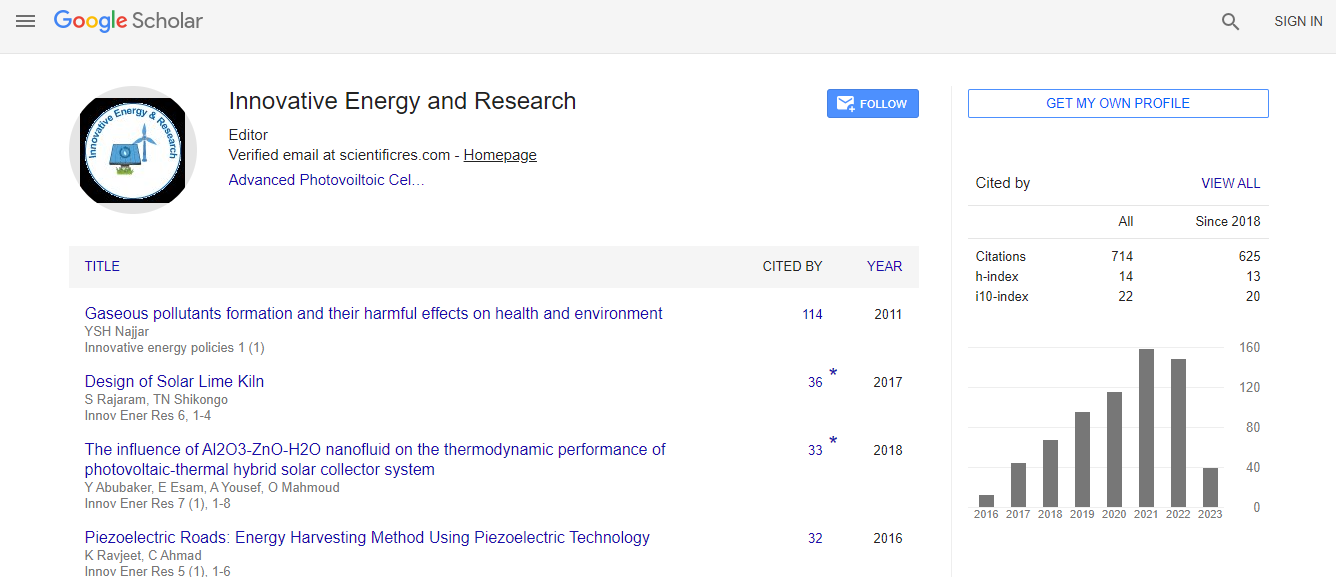Our Group organises 3000+ Global Conferenceseries Events every year across USA, Europe & Asia with support from 1000 more scientific Societies and Publishes 700+ Open Access Journals which contains over 50000 eminent personalities, reputed scientists as editorial board members.
Open Access Journals gaining more Readers and Citations
700 Journals and 15,000,000 Readers Each Journal is getting 25,000+ Readers
Google Scholar citation report
Citations : 712
Innovative Energy & Research received 712 citations as per Google Scholar report
Innovative Energy & Research peer review process verified at publons
Indexed In
- Google Scholar
- Open J Gate
- Genamics JournalSeek
- RefSeek
- Hamdard University
- EBSCO A-Z
- Publons
- Euro Pub
- ICMJE
Useful Links
Recommended Journals
Related Subjects
Share This Page
Microstructural design in hydrogen fuel generation and storage
Joint Event on 2nd International Conference on Renewable Energy and Resources & Energy Materials and Fuel Cell Research
Jerzy A Szpunar
University of Saskatchewan, Canada
Keynote: Innov Ener Res
Abstract
Hydrogen has been recognized as a clean and sustainable fuel. However, still many problems have to be to be solved in the area of generation, transport, and storage of this fuel for the future hydrogen-based economy to be realized. The reaction of water with activated aluminum powder is considered as one of the methods to generate hydrogen. The reaction produces also aluminum hydroxide (Al(OH)3 or AlOOH) as the byproduct; these compounds change to alumina (Al2O3) after calcination process, and alumina can produce aluminum. Hydrogen production rate can be increased if an effective surface area of aluminum exposed to oxidation is increased. Ball milling process is considered as a method that remarkably changes the microstructure of morphology of aluminum hydroxides and can produce submicron or nano-sized particles. We found that microstructural refinement can be used to promote the reaction and allow increasing the production of hydrogen. The addition of water-soluble salts (potash or salt) also allows increasing the oxidation rate and hydrogen generation. However, we discovered that the presence of salt had much smaller influence than microstructural modifications. The traditional shrinking core model was modified to explain the kinetics of the reaction between aluminum particles and the fluid. The storage of hydrogen will also require structural modification of the storage system. One a storage system that was developed by us will be discussed. We designed a Pd-graphene composite for hydrogen storage with spherical shaped nanoparticles of 45 nm size homogeneously distributed over a graphene substrate. This new hydrogen storage system has attractive features like high gravimetric density, ambient conditions of hydrogen charge and low temperature of the hydrogen discharge. The palladium particles produce a low activation energy barrier to dissociate hydrogen molecules These Pd particles, have to be nano-size and homogeneously dispersed on the graphene surface, to serve as efficient hydrogen receptors and further facilitate a dissociation and diffusion of hydrogen and storage in graphene via a spillover process. The hydrogen storage capacity in such a combined metal-graphene system could be significantly increased compared to storage in graphene or in metal. In this project, we optimized the structure of Pd/graphene to allows a hydrogen uptake at ambient conditions and discharging of hydrogen at low temperature. Detailed analysis of the mechanism of hydrogen storage using ab-into calculation for graphene metal system is presented.Biography
J.A. Szpunar received his PhD and DSc. degrees from Academy of Mining and Metallurgy in Cracow. He joined the Department of Mechanical Engineering at the University of Saskatchewan in August 2009, as Tier I Canada Research Chair. He came from McGill University where he was Professor of Materials Science and Birks Chair in Metallurgy. His research interests extend to various areas of materials related investigations. In particular he has longstanding interests in deformation and recrystallization processes in metals; in structure and properties of thin films; in electronic interconnects; in high temperature oxidation and corrosion; in synergy of wear, erosion and corrosion; in the applications of X-ray and neutron diffraction techniques to structure of grain boundaries and other interfaces; in hydrogen ingress into nuclear materials; in hydrogen generation and storage: in intergranular fractures; in fatigue and failure; properties of nanocrystalline materials and properties of nuclear materials and nuclear fuel. He was a leader of 49 major research projects – mostly materials related investigations. The results of his research are presented in more than 950 research papers including about 600 journal publications.
E-mail: jerzy.szpunar@usask.ca

 Spanish
Spanish  Chinese
Chinese  Russian
Russian  German
German  French
French  Japanese
Japanese  Portuguese
Portuguese  Hindi
Hindi 
